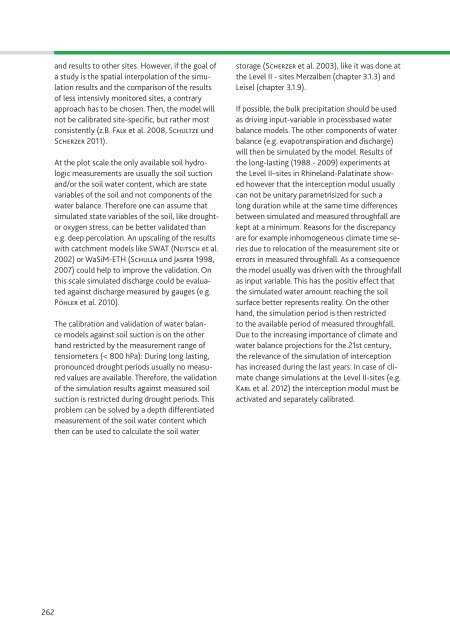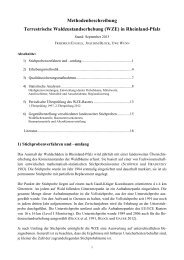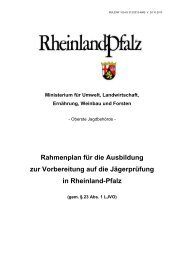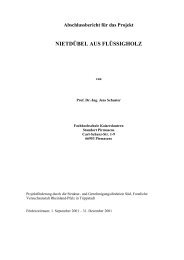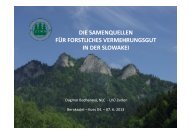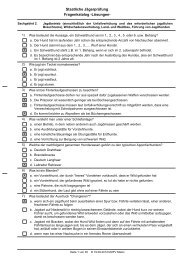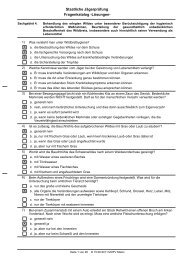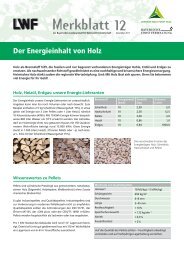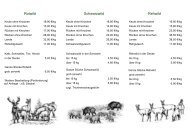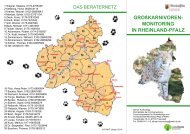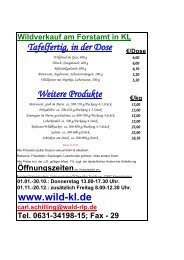wasserhaushaltsuntersuchungen im rahmen des forstlichen umwelt
wasserhaushaltsuntersuchungen im rahmen des forstlichen umwelt
wasserhaushaltsuntersuchungen im rahmen des forstlichen umwelt
Sie wollen auch ein ePaper? Erhöhen Sie die Reichweite Ihrer Titel.
YUMPU macht aus Druck-PDFs automatisch weboptimierte ePaper, die Google liebt.
262<br />
and results to other sites. However, if the goal of<br />
a study is the spatial interpolation of the s<strong>im</strong>ulation<br />
results and the comparison of the results<br />
of less intensivly monitored sites, a contrary<br />
approach has to be chosen. Then, the model will<br />
not be calibrated site-specifi c, but rather most<br />
consistently (z.B. FALK et al. 2008, SCHULTZE und<br />
SCHERZER 2011).<br />
At the plot scale the only available soil hydrologic<br />
measurements are usually the soil suction<br />
and/or the soil water content, which are state<br />
variables of the soil and not components of the<br />
water balance. Therefore one can assume that<br />
s<strong>im</strong>ulated state variables of the soil, like drought-<br />
or oxygen stress, can be better validated than<br />
e.g. deep percolation. An upscaling of the results<br />
with catchment models like SWAT (NEITSCH et al.<br />
2002) or WaSiM-ETH (SCHULLA und JASPER 1998,<br />
2007) could help to <strong>im</strong>prove the validation. On<br />
this scale s<strong>im</strong>ulated discharge could be evaluated<br />
against discharge measured by gauges (e.g.<br />
PÖHLER et al. 2010).<br />
The calibration and validation of water balance<br />
models against soil suction is on the other<br />
hand restricted by the measurement range of<br />
tensiometers (< 800 hPa): During long lasting,<br />
pronounced drought periods usually no measured<br />
values are available. Therefore, the validation<br />
of the s<strong>im</strong>ulation results against measured soil<br />
suction is restricted during drought periods. This<br />
problem can be solved by a depth differentiated<br />
measurement of the soil water content which<br />
then can be used to calculate the soil water<br />
storage (SCHERZER et al. 2003), like it was done at<br />
the Level II - sites Merzalben (chapter 3.1.3) and<br />
Leisel (chapter 3.1.9).<br />
If possible, the bulk precipitation should be used<br />
as driving input-variable in processbased water<br />
balance models. The other components of water<br />
balance (e.g. evapotranspiration and discharge)<br />
will then be s<strong>im</strong>ulated by the model. Results of<br />
the long-lasting (1988 - 2009) exper<strong>im</strong>ents at<br />
the Level II–sites in Rhineland-Palatinate showed<br />
however that the interception modul usually<br />
can not be unitary parametrisized for such a<br />
long duration while at the same t<strong>im</strong>e differences<br />
between s<strong>im</strong>ulated and measured throughfall are<br />
kept at a min<strong>im</strong>um. Reasons for the discrepancy<br />
are for example inhomogeneous cl<strong>im</strong>ate t<strong>im</strong>e series<br />
due to relocation of the measurement site or<br />
errors in measured throughfall. As a consequence<br />
the model usually was driven with the throughfall<br />
as input variable. This has the positiv effect that<br />
the s<strong>im</strong>ulated water amount reaching the soil<br />
surface better represents reality. On the other<br />
hand, the s<strong>im</strong>ulation period is then restricted<br />
to the available period of measured throughfall.<br />
Due to the increasing <strong>im</strong>portance of cl<strong>im</strong>ate and<br />
water balance projections for the 21st century,<br />
the relevance of the s<strong>im</strong>ulation of interception<br />
has increased during the last years. In case of cl<strong>im</strong>ate<br />
change s<strong>im</strong>ulations at the Level II-sites (e.g.<br />
KARL et al. 2012) the interception modul must be<br />
activated and separately calibrated.


